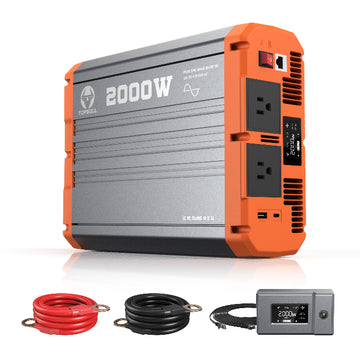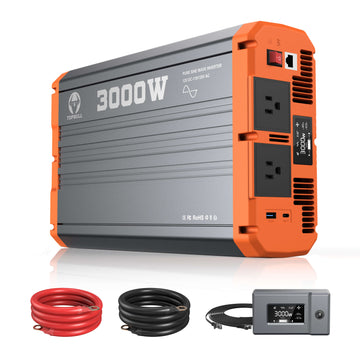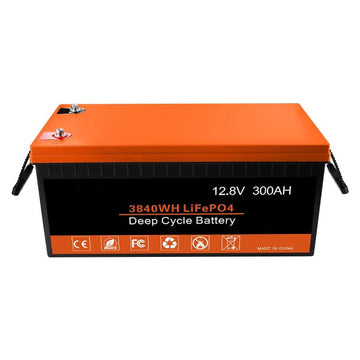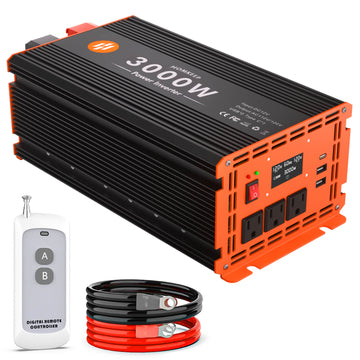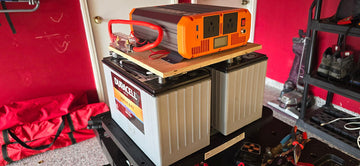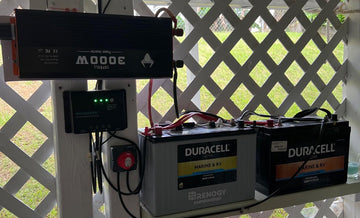Solar panels, the core component of a solar energy system, are responsible for converting solar energy into electricity. However, a common question for many people is: how many volts of electricity can a solar panel actually produce? This article will delve deeper into this topic, looking at the basic concepts of voltage and power, analysing the output voltage characteristics of solar panels and the factors that affect them, and answering some of the common questions related to solar panel voltage.
Basic Concepts of Voltage and Power
Before we can understand the voltage generated by solar panels, we first need to clarify the basic concepts of voltage and power. Voltage is a measure of the potential difference, which represents the force pushing a charge as it moves through an electric field, and is measured in volts (V). Power, on the other hand, is the work done per unit of time, i.e., the rate of energy conversion, in watts (W). In an electric circuit, the relationship between voltage, current, and resistance follows Ohm's law (V=IR), but the output characteristics of solar panels do not exactly follow this simple relationship.
The relationship between voltage and power
Although voltage and power are two different physical quantities, they are closely related. In an electric circuit, voltage is the force that drives the flow of current, while power is the work done by this force per unit of time. Thus, the product of voltage and current represents the power in a circuit.
However, it is important to note that a high voltage does not necessarily mean that the power is high. Power also depends on the amount of current. For example, in a circuit with a high voltage but a low current, the power may not be high, while in a circuit with a low voltage but a high current, the power may be high.
Output Voltage Characteristics of Solar Panel
Non-linear variation: The output voltage of a solar panel shows non-linear characteristics with changes in light intensity and temperature. When the light is enhanced, the output voltage usually increases; while when the temperature increases, the output voltage may decrease due to the thermal effect inside the solar panel.
Maximum Power Point (MPP): Under specific light and temperature conditions, there exists a maximum power point (MPP) of a solar panel, when the product of output voltage and current (i.e., power) reaches its maximum.MPP is a key parameter for solar panel design and system optimisation.
Open-circuit voltage (Voc) and short-circuit current (Isc): In the open-circuit state (i.e., when no load is connected), the solar panel will output a maximum open-circuit voltage (Voc). And in the short-circuit state (i.e. when the positive and negative terminals are directly connected), a maximum short-circuit current (Isc) will flow. However, in practice, neither of these states is the operating state of a solar panel.
Different types of solar panels (e.g., monocrystalline silicon, polycrystalline silicon, and thin-film solar cells) have different output voltage characteristics. In general, monocrystalline silicon panels have the highest efficiency and output voltages, usually between 20V and 30V, while thin film cells may output lower voltages but perform better under low light conditions.
Factors affecting the output voltage of solar panels
- Light intensity: light intensity is one of the main factors affecting the output voltage of solar panels. The stronger the light, the more photon energy absorbed by the solar panel, the greater the electric potential generated, and thus the higher the output voltage.
- Temperature: Temperature also has a significant effect on the output voltage of solar panels. Generally speaking, as the temperature rises, the output voltage of the solar panel will decrease slightly. This is because higher temperatures increase the rate of thermal movement of carriers inside the solar panel, leading to an increase in the rate of compounding of electrons and holes, which reduces the output voltage.
- Solar panel type: Different types of solar panels have different photoelectric conversion efficiency and output voltage characteristics. For example, monocrystalline silicon solar panels usually have higher photoelectric conversion efficiency and more stable output voltage characteristics; while polycrystalline silicon and amorphous silicon solar panels may exhibit lower output voltage under certain conditions.
- Size and connection: The size and connection of the solar panel will also affect its output voltage. Generally speaking, larger solar panels are able to produce higher voltages; and connecting multiple solar panels in series can further increase the output voltage.
- Load conditions: Load conditions are also one of the most important factors affecting the output voltage of a solar panel. After connecting a load, the output voltage of the solar panel will drop and stabilise at a specific value. This value depends on the match between the impedance of the load and the internal resistance of the solar panel.
Solar panel output voltage is DC or AC
The output voltage of a solar panel is direct current (DC). Solar panels convert the sun's energy into electricity through the photovoltaic effect, and the current generated in this process is a DC current, so its output voltage is also DC. DC is characterised by the fact that the direction of the current always remains the same, unlike alternating current (AC), which is commonly found in household power grids and changes direction periodically.
In a solar power system, the DC power generated by the solar panels usually needs to be converted to AC power by an inverter in order to power a home or commercial electrical device. An inverter is a power electronic device that converts DC power to AC power and regulates the output voltage and frequency to match grid requirements or specific application needs.
Therefore, although the solar panel itself outputs DC power, in practical applications, we usually convert it to AC power for use through an inverter.
How to Calculate the Voltage of a Solar Panel
The basic unit of a solar panel is a solar cell (also known as a photovoltaic cell), each of which generates a certain electric potential in response to light, which drives the flow of current. For a single solar cell, the open circuit voltage (Voc) is usually between 0.5V and 0.7V. However, in practice, we usually connect multiple solar cells in series to increase the output voltage.
Number of cells in series:
The output voltage of a solar panel is the sum of the open circuit voltages of all the cells connected in series on it. For example, if a solar panel has an open-circuit voltage of 12V and each solar cell has an open-circuit voltage of 0.6V, then the solar panel consists of approximately 20 solar cells in series (12V / 0.6V = 20).
Operating Voltage (Vmp):
In practice, solar panels usually do not operate at their open-circuit voltage, but at the maximum power point (MPP). At this point, the solar panel will output an operating voltage (Vmp) slightly lower than the open-circuit voltage, and at the same time output a corresponding maximum current (Imp) to achieve maximum power output. The exact value of the operating voltage depends on the design and manufacturing process of the solar panel, as well as the operating conditions (e.g. light intensity and temperature).
Use the product specification sheet:
The most accurate method is to consult the product specification sheet of the solar panel. The specification sheet usually clearly gives key parameters such as open circuit voltage (Voc), operating voltage (Vmp), short circuit current (Isc) and maximum power point current (Imp) of the solar panel.
How much voltage can a solar panel produce
Since different manufacturers and different types of solar panels have different design parameters, there is no single output voltage value that applies to all solar panels. However, in general, the output voltage of a solar panel can range from a few volts to tens of volts, depending on the number of cells inside and how they are connected.
How much voltage can a 200W solar panel produce
For a typical 200W solar panel, the output voltage may be between 30V and 40V at STC, but this is only a rough estimate. In reality, when the solar panel is connected to different loads, its output voltage will change to maintain a stable output power.
How much voltage can a 300W solar panel produce
At STC, for a 300W monocrystalline or polycrystalline solar panel, the open-circuit voltage (Voc) is usually between 40V and 50V, while the operating voltage (Vmp, maximum power point voltage) when connected to a load at the time of use may be between 25V and 35V.
How much voltage can a 500w solar panel produce
Under standard test conditions (STC), the voltage of a 500W solar panel is usually its maximum power point voltage (Vmp). For most 500W solar panels, the Vmp is usually between 35V and 45V. This means that under ideal lighting conditions (1000W/m² irradiance, 25°C temperature) the panel is able to deliver maximum power within this voltage range.
In addition, the open-circuit voltage (Voc) will usually be between 40V and 55V, with the exact value varying depending on the brand and model.
FAQ
Q: Can solar panels directly power household appliances?
A: No. Solar panels do not provide direct power because they generate DC power and most household appliances require AC power. An inverter is required to convert the DC power to AC power.
Q: Is the output voltage of the solar panel fixed?
A: No, the output voltage of solar panels varies with light intensity, temperature and load conditions.
Q: How can I increase the output voltage of a solar panel?
A: The output voltage can be increased by increasing the number of solar panels in series, but care should be taken not to exceed the input voltage range of the inverter. Also, optimising the system configuration and choosing the right inverter can improve the overall performance of the system.
Q: What is the optimal operating voltage for solar panels?
A: Typically, the optimal operating voltage is around 30V for monocrystalline panels and around 20V for polycrystalline panels.
Q: How much does the voltage of a solar panel drop on a cloudy or foggy day?
A: On cloudy or foggy days, when light intensity is reduced, the voltage usually drops anywhere from 30% to 50%, depending on the specific weather conditions and type of panel.

